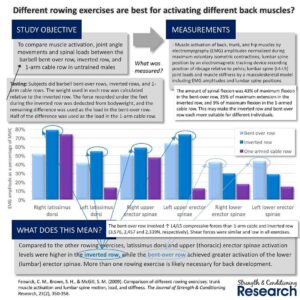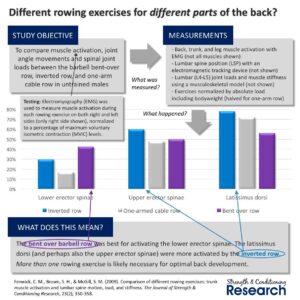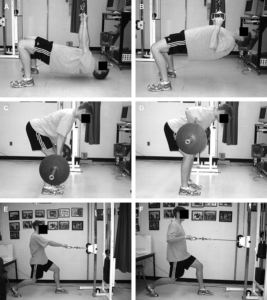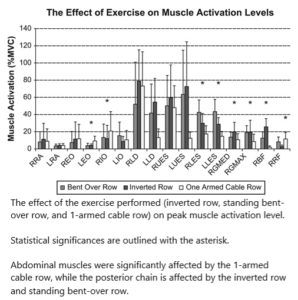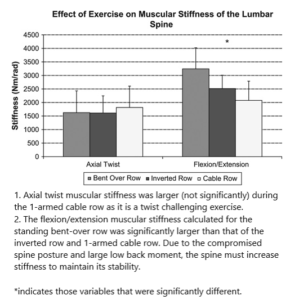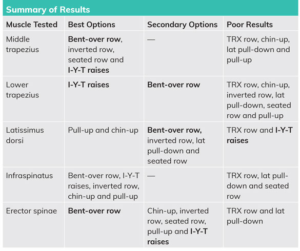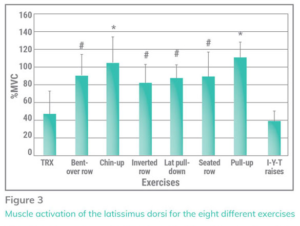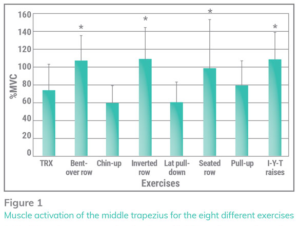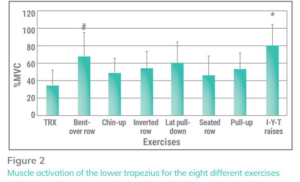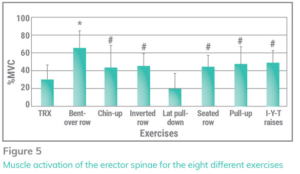BODYWEIGHT or INVERTED ROWS
Click on Image to Enlarge
MOMENT ARM & EMG STUDY
LATISSIMUS DORSI MIDDLE REGION, UPPER & LOWER ERECTOR SPINAE
JOINT COMPRESSION, AXIAL TWIST & FLEXION-EXT MUSCULAR STIFFNESS
– Inverted Body Row, Standing 1-Arm Cable Row, BB Row
Comparison of Different Rowing Exercises: Trunk Muscle Activation and Lumbar Spine Motion, Load, and Stiffness – 2009 – Fenwick, McGill
Procedures
– matched the loading between exercises relative to inverted row
Electrode Placement
– Latissimus Dorsi: over the muscle belly when the arm was positioned in the shoulder mid-range
Results
Latissimus Dorsi – Middle: inverted row 80% · standing 1-arm cable row 70% · bent over bb row 55%
+ Upper erector Spinae: inverted row 60% · bent over bb row 50% · standing 1-arm cable row 50%
+ Lower erector Spinae: bent over bb row 40% · inverted row 30% · standing 1-arm cable row 20%
Results – Figure 4 below
Joint Compression: bent over bb row · standing 1-arm cable row · inverted row
– the compromised spine angle and large moment caused by the load in the hand contributed to the high joint compression
Result Figure 5 below
Axial Twist Muscular Stiffness: standing 1-arm cable row · bent over bb row · inverted row
Flexion/Extension Muscular Stiffness: bent-over bb row · inverted row · standing 1-armed cable row
– Due to compromised spine posture and large low back moment, the spine must increase stiffness to maintain its stability
EMG STUDIES
UPPER LATS, INFRASPINATUS, MIDDLE-LOWER TRAPS & ERECTOR SPINAE
– Seated Cable Row, Inverted Body Row, Prone LYT, BB Row
– Lat Pulldown, Chinup, Pullup
What is the best back exercise? – 2018 – Edelburg – PDF Link to Edelburg Thesis .
– Subjects had previous resistance training experience
Procedure
– 19 males; all had previous resistance-training experience and were familiar with the exercises; 5 reps @70% 1RM or bodywt; rest 2min
Lat Pulldown: overhand grip; medium width
Pullup: pronated overhand grip; medium width; Chinup: supinated underhand grip; shoulder width
Bent-over BB Row: overhand grip; wrists, elbows shoulders straight line; pulled toward the sternum keeping a flat back
Inverted row: medium-width grip; body straight, heels on floor, arms fully extended; pulled chest toward bar; shoulder blades retracted
Seated Row: Seated pulley machine; V-bar handle; feet on platform, knees bent, straight back; chest up; elbows back to front of stomach
I-Y-T Raises: prone on bench; palms facing for the letter “I”, palms facing for the letter “Y”, palms facing the floor for the letter “T”
Results MVC
Latissimus dorsi – Upper Fibers – Extension, adduction, horizontal abduction, and internal rotation of the shoulder
· Over 100% – pullup > chinup
· 85% → 82% – bent-over bb row > seated row > lat pulldown > inverted row
· 45% → 40% – TRX > IYT
Infraspinatus – External rotation of the shoulder (this is one of the rotator cuff muscles)
· 58% → 50% – IYT > bent over bb row > pullup > chinup > inverted row
· 40% → 35% – seated row > TRX > lat pulldown
Middle trapezius – Upward rotation and adduction of the scapulae
· Over 100% – IYT > bent over bb row > inverted row > seated row
· 80% → 75% – pullup> TRX
· 60% – chinup > lat pulldown
Lower trapezius – Depression of the scapulae
· 80% – IYT
· 62% → 42% –bent over bb row>lat pulldown > pullup >inverted row > chinup> seated row
· 35% – TRX
+ Erector spinae – Extension and lateral flexion of the spine
· 62% – bent over bb row
· 48% → 40% – IYT > pullup > chinup > inverted row > seated row
· 28% → 20% – TRX> lat pulldown
